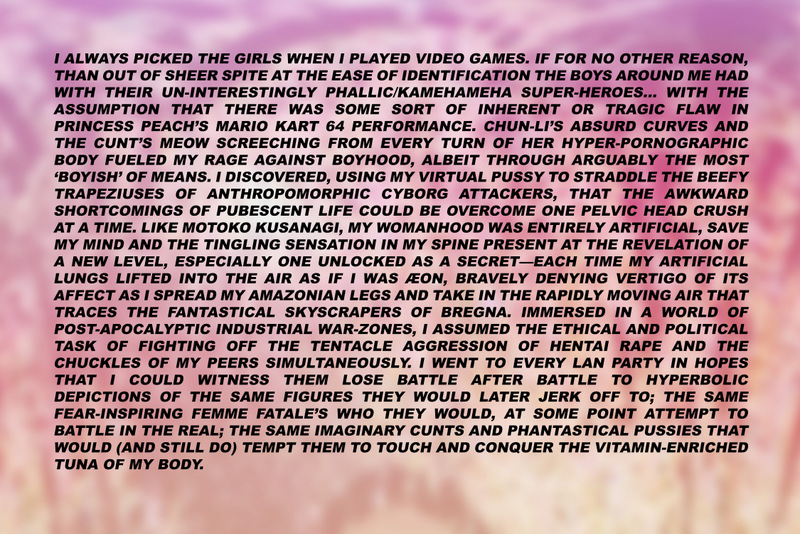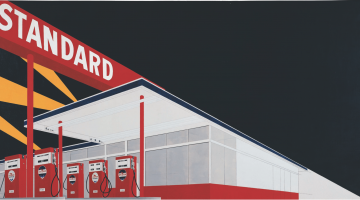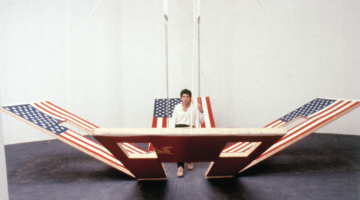A fragment on cultural influence: I was sitting with about 10 high school students in an empty taco shop on Avenue A—they were in an after-school program for kids who are into art; they go around to see exhibitions and talk to artists, writers, and curators. The afternoon we met, they had just been to the New Museum Triennial, Surround Audience, and brought writing to share. One young woman started reading hers about how much she loved the green skin and long yellow braids of Juliana Huxtable’s photograph Untitled in the Rage (Nibiru Cataclysm) (2015). After describing Huxtable’s text-piece UNIVERSAL CROP TOPS FOR ALL THE SELF-CANONIZED SAINTS OF BECOMING, she wrapped up her analysis: “I think what the artist is saying is that you can become whoever you want to be. That you can be free.”
That suite of Huxtable text and photographs, coupled with the iconic life-sized sculpture Juliana (2015) by artist Frank Benson, made her, as Vogue put it, “the star of the New Museum Triennial”—bringing her into the consciousness of everyone from Takashi Murakami to those New York City public school children. I’ve admired Juliana Huxtable for years and followed her collective the House of LaDosha. I was happy to see her getting the attention she deserves—transcending the perception of her as a nightlife personality and assuming the status of serious cultural contender. I published an interview with her in SFAQ two years ago and wanted to reconnect after this explosion of attention, to talk about blackness and abstraction, art, celebrity, and her belief in the politics of beauty.
I’ve been trying to deal with David Getsy’s book Abstract Bodies and I know you were just on a panel with him at Art Basel Miami, so in that vein I wanted to ask: How do you think about your relationship to representing bodies, and/or of abstraction, in your work?
When you’re studying art history, modernism has a specific lineage with authors, critics and theorists that contribute to what it signifies. Most of those artists—at least the ones that are given the space or the authority to suggest that they were the forerunners of abstraction—were explicitly engaging abstraction as a theoretical, art historical practice. The way that abstraction was talked about on that panel was very white to me—as though we could avoiding the trappings of representation by turning toward abstraction as an alternative to dealing with what identity means. That is a privilege. There is a whole history about what abstraction means, and a critical dialog that allows people to receive and interact with it. There is still a lot that hasn’t been explored in bodies. There is a lot in bodies that can create new trajectories and end up in abstraction, or opening up new ways of dealing with representation.
![Untitled in the Rage (Nibiru Cataclysm), 2015. Color inkjet print, 40 x 30 inches. Courtesy of the artist. SFAQ[Projects] Pullout Poster, Issue 23.](https://www.sfaq.us/wp-content/uploads/2016/03/tumblr_nm3j6mRx7p1uqtnv7o1_1280-600x800.jpg)
Untitled in the Rage (Nibiru Cataclysm), 2015. Color inkjet print, 40 x 30 inches. Courtesy of the artist. SFAQ[Projects] Pullout Poster, Issue 23.
No young artist I know values the distinction between abstraction and representation as a binary—so why are academics trying to reclaim a formal construct from a previous generation?
I don’t think about abstraction or representation as an antagonism. People just go back and forth—they co-exist. What some people might think of as abstraction might also be the most literal thing that you can do. When you’re reading about abstract art, the burden of what is politicized is always placed on the “woman abstract artist”—she’s the one that takes on the burden of articulating what femininity is in abstract art, and only in writing about her work do we acknowledge the male signifiers within abstraction that she’s responding to. I think it might be interesting to look at historically significant abstract art for the ways that it has always been charged with identity and not look for the ways it could potentially be read through a lens that, as an author, you’re acknowledging you’re applying, which ultimately serves to validate the idea that it’s neutral in the first place.
In There Are Certain Facts That Cannot Be Disputed (2015), I was thinking about how my voice is present, and how much of my self is given. It’s about what performance means for someone like me, who people have access to through wide circulation of images. The idea of performance art from an earlier moment was about provoking presence via the body, and to a certain degree the “cult of youth”—I am really turned off by that idea because of the expectations and the desires people have to consume me. The New Museum’s Triennial was the apex of that, where people would come up to me and say: “I saw your body.” They would see Frank Benson’s sculpture of me and think that they are accessing me. I see performance art as a way for me to engage what presence signifies within this cult of personality. The text, sound, and a lot of the visuals, are a form of abstraction in the sense that, within the performance itself, I do very little. You hear my voice and it’s distorted, sometimes it’s stripped down to a base element—I’ve been using more and more devices to manipulate my voice. That is a form of abstraction because it’s taking the desire people have of accessing to me, and feeding them an illusion—most of the video, sound, and text is pre-recorded.
I consider my photographic piece Untitled (Psychosocial Stuntin’) (2015) as dealing in abstraction—even though there is something that resembles “me” in it—that image is based on household black imagery, where you have black women running through a jungle and there is moonlight on her and panthers around. I’m taking these visual motifs that are politically charged, and which are themselves a way of deriving or sublimating a very literal political concept into something visual. I try to take these aesthetics and abstract them even more—to see what remains—to the point where it is almost a test: “Will this be read as black art?” And it wasn’t. Most of my art was read as “trans art.” To me that is a failure of the way people perceive things as representational or not—these are influenced by, and in dialog with, all of the visual markers of black experience, even though they are simplified into a color language. Black people would see it as “black art,” but most of the people in the New Museum instead saw it as “digital” and “trans.”

Untitled (Psychosocial Stuntin’), 2015. Color inkjet print, 40 x 30 inches. Courtesy of the artist.
Were they even looking at it and seeing something that signaled a “trans” identity, or were you just labeled a “trans artist” and then that gets mapped onto everything conceptually?
Yes, that is what’s always happening, which is why I think it would be interesting to approach a lot of what’s considered purely abstract art in that identity framework—from the identities of straight white men.
If we take the Triennial—the conjunction of your text/image wall pieces and Frank Benson’s sculpture of you—as representing your coming into a wider public awareness—from the outside it seemed like you were being used as a symbol in the media and by institutions to address a host of issues that they don’t actually want to deal with, but they can instead circulate a very attractive picture and feel like, “that did something.” You’re one of the smartest people I know, and I want to know what that experience was like—being picked up by this machinery that seems to care very little for your actual ideas or work, but a lot for your image?
Generally, I share that sentiment. I have a complicated relation to what that sculpture of me signifies because that was not supposed to be in the Triennial. I agreed to do that under a different set of conditions. Agreeing to a sculpture that will be shown in a commercial gallery in London ultimately functions very differently than one appearing in the New Museum’s Triennial. Going into the Triennial, I wasn’t sure how I felt about it. I thought the fact that this exists is probably better than the alternative—I had no clue that it would become the icon of that show. While that was happening, I appreciated the moments that people did write about my work seriously, but mostly what people were writing about me was as a “muse”—they didn’t know I did the images or text myself.
“Muse” is a word that has been used a lot about you. The truth, of course, is that you inspire a lot of people, and they have made work in relation to you and with you, in collaborations; but really, a “muse” is a disempowered position—it always made my skin crawl to read.
To me the idea of a muse is someone who is maybe interesting, or inspiring, but is fundamentally talentless and most of their skills come from social charm, which is so enchanting that people with skills, usually men, are the ones to execute the ideas that you suggest by your existence, but maybe don’t have the ability to manifest on your own. It’s all so sexist. I hadn’t dealt with being called a muse before.
Takashi Murakami bought an edition of Benson’s sculpture from that show. Murakami’s assistant came up to me and said, “He bought this sculpture. He’s really obsessed with you. Can he get your contact information?” I was like cool, whatever—that is not a negative interaction, but it shows when people are interacting with a representation, with a sculpture, they feel on some level that they are interacting with me. My existence and what I do will always be linked to this weird object that is already esteemed at this ridiculous monetary value, which will continue to exist, and my work and all of my future labor will, in a way, continue feeding into its value.
I had conflicting feelings watching you blow up during that show—I was happy because I love your work and want people to know about it. And, at the same time it was frustrating because I was reading the press and thinking it was superficial. Not that it was hurtful . . . it just wasn’t substantial or insightful.
I saw it as a challenge.
How did you engage that challenge?
I’m more conscious of press things. There is a certain value in visibility. For little black girls on Tumblr, me being in Vogue signifies something, and I’m not going to let my jadedness stop me from doing things that might be significant in that way. It’s made me more self-aware of my work.
When you came to my class at BHQFU a few years ago you asked everyone to read Herculine Barbin (1872), the heartbreaking memoir of a nineteenth century intersex person, and that showed one example of the insane curiosity a trans or intersex body exerts in the Western imagination. How does that relate to the images you produce of your own body? And the images that circulated of the Frank Benson’s nude sculpture of you?
I try to be joyful and playful with it—so often when you are overly politicized you aren’t allowed to be playful unless you are dealing with tropes of how black people have been on the losing end of historical imagery. I mean, that is important to do—when I think of Kara Walker I think of that. Those two images for the New Museum were so much about abstracting from a literal idea of blackness. Which is why I love something as simple as changing my skin. It’s so funny, a very basic thing to do—change the color of your skin—but it actually affected the way people interacted with the work. People would come up to me, or write to me about the work, saying, “I love those Buddhist references!”—What? Those are Bantu knots! But that is what I wanted to do—see who can access the images, and push the question of authenticity. There is something happening that is really interesting is that the cultural markers of blackness have been completely abstracted from black bodies.
Can you expand on that?
Cornrows: ten years ago white girls were not walking down runways with cornrows. If it did happen, it was solely for shock value—and not anywhere near the rate it is happening now. Because of how gender has played out historically, the idea of the wigger for a long time was a white male figure, because white men are more entitled to colonize culturally, whereas white women maybe had to wait 15 years longer to do it. But in the past five years white women have been having their moment—appropriating the way black people dress, accents, solely in the way that they exist performatively in music. White women modify their body to approximate a thick Latina girl, but ultimately trying to access something that blackness represents. Because of the way markers of black culture have been abstracted from black bodies, our sense of entitlement to them has been totally taken away. My images are about trying to hide enough to see in what ways questions of authenticity can exist, even if it is not perceived explicitly as black.
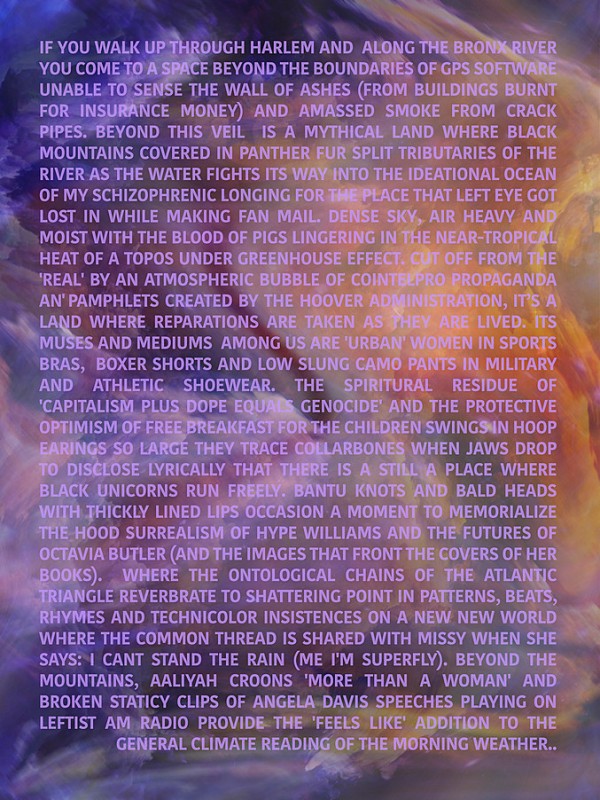
Untitled (Casual Power), 2015. Color inkjet print. 40 x 30 inches. Courtesy of the artist.
How does this connect to conversations about gender identity? How do they overlap and then peel back apart?
The question of authenticity with black people is a gut-check. The instincts that you have for living—those instincts cannot be codified. The second you codify them you’re going to reach that point where you’ve said something that is inherently problematic. But with trans culture and the culture surrounding gender variance, it’s not perceived as racially specific—I mean there are ways in which racial differences and hierarchies and privileges and violences are played out in that narrative, but essentially “trans” signifies something that is beyond race. I knew it was going to happen with Rachel Dolezal. I knew that immediately people would say: “transracial is the same as transgender.” To really get into the specifics of what that means you have to get into the ethical questions, but ultimately there is no real justification for why they are different, outside of a belief that there are some innate qualities attached to gender in ways that we know there are not innate qualities attached to race. But to say that reinforces an idea many people think is problematic: that there is some innate quality of gender, even if it is just a base innateness. You can study things across history, like that there are gender-variant people in every race across history, which is not the same with racism. Femininity, at least the trappings of what that signifies, is a voice, a stance, a set of desires, how you relate to who you desire—and those markers of gender can exist in any cultural context. But, no one who grew up without access to American television and popular culture would wake up and behave in a way that Rachel Dolezal does, because they would have zero way of accessing that. They would have zero perception of what blackness would signify, because they have bled into each other, and I think once you open the floodgates you can’t really go back, at this point I’m just like, “okay, let Rachel Dolezal check black”. I think that is really stupid, delusional, and insane, but I’m so uninterested in the debates surrounding questions of authenticity when you get to the intersection of race and gender, specifically blackness and transness.
I’ve started to consciously avoid addressing the trans thing, because it’s a slippery slope, and because it is something that, by virtue of the fact that it brings up such a spectrum, to analyze it you need something like a gut-check. There are sadistic cultural impulses that are playing themselves out in the public consumption of trans right now. Putting Caitlyn Jenner on the cover of a magazine, days after she’d gotten surgery, literally months after she decided to transition, is sadistic to me. I think the trans conversation is at a place where some of the darkest cultural impulses are playing out, and you can’t actually say anything about it because to say something about it you are categorized with the most toxic, conservative, repressive aspects of society. I went on a Twitter rant about this today.
What did you say?
[Reads tweets]
And how did people respond?
I actually don’t have as many followers on Twitter as I do on Instagram, but if I said that on Instagram there would be so many Internet trolls—I would be accused of all sorts of terrible things. No one is allowed to be honest and have real conversations. There are some men who literally think it’s funny and entertaining to dress up as a woman and call themselves trans. It’s happening. But you’re not allowed to say that is happening because if you do you are giving credence to these super conservative feminists who think that all transwomen are rapists masquerading as women so that they can enter into “women only” spaces that have historically served as “spaces of safety.” There are so many nuances to how these things exist, which have always been difficult—there has never been the utopia of women only spaces—white women used to have black women raped and murdered just for looking at them. It’s never been “easy” or “safe.” I’m really disgusted by what’s happening right now, and I want to be able to say: they put Caitlyn Jenner on the cover of that magazine because they would get a lot of money and it’s kind of crazy. She represents a representation of transwomen that’s totally a circus—let’s just keep it trill. I think that is sadistic and that it actually hurts transpeople in the end.
It also underscores the importance of images and representations. Images matter and are partly how we present other people’s lives as valuable, and aesthetics are the way we do it. It’s really scary that otherwise sophisticated self-proclaimed “progressive” people are not able to have disagreements without it becoming immediately incendiary.
And, I refuse to do the “trigger warning” thing—it’s the most self-indulgent narcissistic thing you can do. The culture that is emerging is trying to counter the gut-check by putting a trigger warning on anything that doesn’t suit every hypothetical intersection of human, which it never will and there is always going to be a battle about that. It’s about saying all things are equal—no they are not, and that is a problem, and pretending that is not the case is not helping anyone.
Which is how I feel about beauty: all of the transwomen who are murdered are presenting themselves as very feminine, specifically aspiring to an ideal of beauty. So many people look at them and say: “They are beautiful.” The threat that beauty represents is that they are approximating what you might call a “normative idea of gender” and they do that as a form of empowerment. But I’m not supposed to express that, or suggest that the achievement of that beauty signifies something political, because then I’d be exclusionary or whatever—and that is just bullshit. I don’t think anyone is being honest about that. But all the same people are obsessed with Lupita—and why? She’s an actress, sure, but she is also a pretty woman—one who undermines a more white hegemonic idea of beauty, but who also aspires to and operates within a space of beauty nonetheless. We don’t talk about why there is a power in that. I would like to expand ideas of beauty too—let’s all get to that point—but not allowing people to get into the difficulty, or to acknowledge what beauty means as a form of empowerment, is crazy.
No small factor of your rise to stardom is that you’re extraordinarily beautiful. The way you look is not an accident; it’s not something that you haven’t considered—
It’s not at all. If I was just doing what I was doing when I was in school, which was an academic hoorah, nobody would have paid attention to me. I do it consciously. I love walking in someplace in the skimpiest dress, celebrating my body. It’s so funny because I’ll go to things with my boyfriend and people will think that he must be a startup dude from San Francisco and I’m his bimbo girlfriend—that happened at Art Basel Miami constantly.
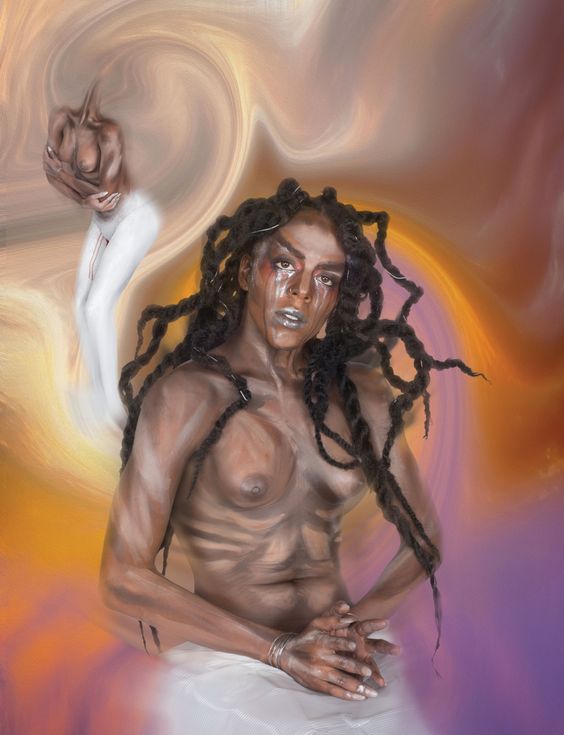
Sympathy for the Martyr, 2015. Color inkjet print, 40 x 30 inches. Courtesy of the artist.
How do you know what they were thinking?
‘Cause that is how people treat me. It’s so obvious. I know when someone thinks that I’m a hooker. I know when someone thinks that I’m a model or a bimbo. I know when people see me and think, “oh, you’re that person that I’ve seen in a bunch of magazines and you probably do something stupid that gets attention, maybe you’re friends with Chloë Sevigny”—those things all come across. It’s kind of fun at this point.
The last time we talked you were primarily in a nightlife context, and you talked about how claiming your space as an artist was extremely politicized, that you were “removing your straightjackets”—how has your relationship to that changed? How do you participate in nightlife as an artistic space, and inversely, how your relation to the art world has changed?
I still do a lot of nightlife. I think my relationship to it has changed in that it is not the sole arena I can explore in. DJing has become my primary thing there; in our last interview I was hosting parties. . .
You had just quit your job at the ACLU and were taking a leap of faith that the community was going to support you in your creative work.
They allow me to have a much freer relationship to both of them. Generally it’s nice because they feed into each other, or they relieve each other. With the art stuff, I have to be aware of navigating the whitest, often wealthiest, people, who at the same time have no real self-critical impulse because they think being a conceptual painter is the same thing as being politically radical—which is crazy. When I feel that way it is so nice to go to a party and just do my thing in a much more dynamic (racially, gendered, etc.) environment. Sometimes when I’m DJing I feel the most free, just taking an idea and having it exist sonically and working through it. I still have some straightjackets on, but way less.
How do you think about the distance between when we talked in 2013 and now—in terms of what you care about, in your life?
I think some of the questions I was dealing with then I’ve started answering. When we talked last time, my relationship to nightlife was very visual and performative, about character types and ornamentation, and I think I’ve found ways of dealing with that and I’ve pushed it over into an artistic practice. Sometimes DJing it’s nice to just get people dancing, but I’ve gotten into playing texts that I’ve made, or maybe totally getting into a more textured approach to mixing sound.
I think there are new challenges emerging. I feel like I am now navigating the art world, which is really bizarre socially—most of my friends in the art world are conceptually-leaning, ostensibly anti-market, Marxist-critical, kind of artists. When I first started doing debate in college and it was like, “I’m in this new field and people generally respect me as smart, but it’s a lot of nerdy white boys. And they appreciated me and there’s a community which is great—but I think I need to get the charge to blaze them.” It happened again when I did “performance debate”—I had earned all my stripes as a critical debater and got to a place where it was a cult of personality around these tragic, pseudo-nihilistic white boys who were all into each other as white male geniuses—like, they read Nietzsche and watch Dave Chapelle. Maybe the art world equivalent now would be . . . well. In that circumstance I felt a similar challenge to what I feel right now. I don’t know how that will manifest yet, but I’m excited to see how it does.
There are artists making work now who are so white, come from money, half of them are from Germany or some Scandinavian country, and are given this credence of being “punk” based on critical posturing. I’m now a lesser inside/more so outside participant in that world. To translate the questions I am trying to deal with into that world is a challenge, and I think it’s important, because there are clusters of the art world given a lot of intellectual weight, paid a lot of critical deference—there is an idea that they are perceived as “progressive,” pushing conversations around certain art practices, and in a lot of ways they are. But I’m like: there is not a single person of color here—Not. A. Single. Person. Of. Color! Maybe there are two Asian dudes, one black queen . . . a single black woman. There is a lot of Marxism being thrown around here. A lot of the white male critic-artists, in some form or another, they write themselves into relevance. People build careers off this, and it’s happening in such a cultural vacuum. So I’d like to do something; this can’t keep happening—and that is what I hope I can change in some way.
